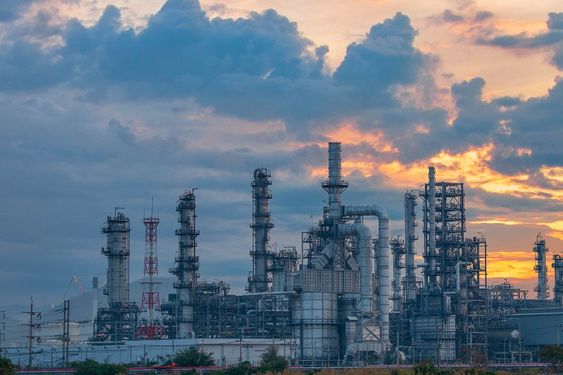The oil and gas industry is a complex and dynamic sector with extensive processes spanning upstream, midstream, and downstream activities. Each stage is critical to the delivery of energy resources that drive global economies. Understanding these components, along with the types of oil and gas and the industry's challenges, provides a comprehensive view of its operations and future directions.
Introduction
The oil and gas industry is a critical sector that drives economies worldwide, providing essential energy production, transportation, and manufacturing resources. This industry operates in a complex landscape involving petroleum product exploration, extraction, refining, and distribution. To fully grasp the basics of this industry, we need to break down its key components, processes, and the challenges it faces.
The Structure of the Oil and Gas Industry
The oil and gas industry can be divided into three major sectors: upstream, midstream, and downstream. Each sector plays a unique role in the journey of crude oil and natural gas from underground reserves to end consumers.
Upstream Sector
The upstream sector is the first stage of the oil and gas industry and is primarily focused on exploration and production (E&P) activities. This sector is critical as it involves locating and extracting the raw materials—crude oil and natural gas—that are essential to the entire energy value chain. The process begins with extensive exploration efforts, which rely on cutting-edge technologies to identify potential oil and gas reserves.
Exploration
Exploration is a highly specialized phase that utilizes geophysical and geological studies to locate oil-rich regions, often found beneath deep-sea beds, deserts, or other remote and difficult-to-reach areas. Companies use advanced tools like seismic surveys, which send shock waves into the earth to map underground structures, and 3D modeling to generate detailed images of potential reservoirs. These techniques help companies reduce risks by providing precise data on where to drill for hydrocarbons.
Drilling
Once a viable location is identified, drilling begins. Initially, test wells are drilled to confirm the presence of hydrocarbons like crude oil and natural gas. This process is known as appraisal drilling and is vital in determining whether the site is commercially viable. If the test wells indicate sufficient resources, further wells, known as production wells, are drilled to begin large-scale extraction.
Production
The production phase involves the extraction of oil and gas from underground reserves. This step can involve traditional drilling techniques or more advanced methods such as hydraulic fracturing (fracking) or horizontal drilling to maximize output. Once the oil or gas is extracted, it is transported to processing facilities where it undergoes initial treatment before moving to the midstream sector for storage and transportation.
Midstream Sector
The midstream sector plays a critical role in the oil and gas industry, focusing on the transportation, storage, and processing of hydrocarbons once they have been extracted. This stage serves as the vital link between the upstream sector, where oil and gas are produced, and the downstream sector, where they are refined and sold to consumers. Without the midstream sector, it would be impossible to move these valuable resources efficiently across vast distances to refineries and markets.
Transportation
Pipelines are the most common and cost-effective way to transport crude oil and natural gas from production sites to refineries or storage facilities. Stretching across countries and continents, pipelines offer a safe and efficient means of moving massive quantities of oil and gas. However, in areas where pipelines are impractical or do not exist, companies rely on shipping tankers, rail systems, and trucks to transport these resources. Shipping tankers are especially critical for moving crude oil across oceans, while trucks and trains handle transportation on land, particularly in regions where pipeline infrastructure is limited.
Storage
Oil and gas often need to be stored before they can be processed or sold. This can happen at various stages of the midstream process, either near production sites or at distribution hubs. Crude oil is typically stored in large tanks, while natural gas can be stored in underground reservoirs or depleted gas fields. Storage is critical for balancing supply and demand, allowing producers to maintain steady supplies even when production fluctuates or markets slow.
Processing
Certain types of natural gas require additional processing before they can be delivered to the market. This involves removing impurities such as water, sulfur, and carbon dioxide and separating valuable natural gas liquids (NGLs) like propane, butane, and ethane, which can be sold separately. This processing ensures that the gas meets market specifications and can be safely transported to consumers.
The midstream sector is essential for maintaining the flow of oil and gas, ensuring that these vital resources reach their destinations in a safe, efficient, and timely manner.
Downstream Sector
The downstream sector is the final phase of the oil and gas industry, focusing on the refining, distribution, and marketing of petroleum products. This sector transforms crude oil into valuable, everyday products such as gasoline, diesel, jet fuel, and petrochemicals, making it essential to powering industries and modern life.
Refining
At the heart of the downstream sector is the refining process, where crude oil is converted into usable products. Refining begins with distillation, where crude oil is heated in a distillation column to separate it into different fractions based on their boiling points. Lighter fractions, such as gasoline, rise to the top, while heavier products like diesel and lubricating oils remain lower in the column. These fractions are further processed and treated to improve their quality and meet market specifications. Additional techniques, such as cracking and reforming, help break down heavier molecules into lighter, more valuable ones, increasing the yield of high-demand products like gasoline and jet fuel.
Distribution
Once refined, petroleum products must be distributed to consumers. This is achieved through an extensive network of pipelines, trucks, and tankers that transport these products to retailers, gas stations, and other distribution points. Pipelines are the most efficient method for long-distance transportation, but trucks and tankers are often used to reach areas that lack pipeline infrastructure. Efficient distribution ensures that products like gasoline and diesel are available to consumers at gas stations, while other products are delivered to industries, airports, and power plants.
Marketing
In addition to refining and distribution, oil companies also focus on marketing their products. This includes selling fuels, lubricants, heating oil, and various chemicals used in industrial applications. Marketing strategies ensure that petroleum products reach the right consumers, whether it's individual drivers, manufacturing plants, or households.
The downstream sector ensures that crude oil is refined into useful products and distributed to consumers worldwide, keeping economies running and industries productive.
Types of Oil and Gas
Understanding the types of oil and gas is essential for grasping the basics of this industry. The two main types are crude oil and natural gas, but they come in various forms that require different extraction and processing techniques.
Crude Oil
Crude oil is a naturally occurring liquid found beneath the Earth's surface. It varies in composition depending on the location of the reserves. Crude oil is classified into different categories based on its viscosity and sulfur content.
- Light Crude: Easier to refine, it produces higher quantities of gasoline and diesel. Light crude is in high demand due to its efficiency in producing valuable products.
- Heavy Crude: Contains more impurities and requires more complex refining processes. While it produces lower-quality products, heavy crude is abundant and often cheaper.
- Sweet Crude: Has a low sulfur content, making it more environmentally friendly and easier to refine.
- Sour Crude: Contains high sulfur levels, making it more challenging to process and refine.
Natural Gas
Natural gas is a vital energy source, often found in conjunction with crude oil. It consists primarily of methane, but it also contains small amounts of other hydrocarbons.
- Associated Gas: Found with oil deposits, this type of gas is either extracted with oil or separated and processed.
- Non-Associated Gas: Found in natural gas fields, separate from oil, and extracted directly.
- Liquefied Natural Gas (LNG): Natural gas can be converted into a liquid state to make transportation easier, especially over long distances.
The Global Supply Chain
The oil and gas industry operates on a global scale, with supply chains spanning across continents. Some of the leading oil-producing nations include Saudi Arabia, Russia, the United States, and Canada. These countries not only extract vast amounts of oil and gas but also influence global energy markets.
OPEC's Role
The Organization of the Petroleum Exporting Countries (OPEC) is a key player in the global oil supply chain. Founded in 1960, OPEC consists of major oil-exporting countries that collaborate to regulate the supply of oil to ensure stable prices. By controlling production levels, OPEC can influence the price of oil globally, impacting both producing and consuming nations.
Key Challenges in the Oil and Gas Industry
The oil and gas industry faces numerous challenges, both economic and environmental, that affect its operations and profitability.
Environmental Concerns
Oil and gas extraction and processing have significant environmental impacts, including greenhouse gas emissions, oil spills, and the degradation of ecosystems. Governments and regulatory bodies impose strict environmental regulations on oil companies to minimize their ecological footprint.
- Climate Change: The combustion of fossil fuels is the largest contributor to global greenhouse gas emissions, driving climate change.
- Sustainable Energy Transition: As the world seeks to transition towards renewable energy sources, the oil and gas industry is under pressure to reduce its reliance on fossil fuels.
Price Volatility
The price of oil is notoriously volatile, influenced by factors such as geopolitical tensions, natural disasters, and market speculation. Companies must navigate these price fluctuations while maintaining profitability and stability.
Technological Advancements
Advancements in technology have revolutionized the oil and gas industry, making it possible to access previously untapped reserves. Technologies like hydraulic fracturing (fracking) and horizontal drilling have opened up new opportunities, especially in shale oil and gas extraction. However, these technologies are not without controversy due to their environmental impact.
The Future of the Oil and Gas Industry
The oil and gas industry is at a crossroads, facing challenges from renewable energy, climate change policies, and evolving consumer preferences. While fossil fuels will remain a significant part of the global energy mix for the foreseeable future, there is a growing need for the industry to adopt sustainable practices and invest in clean energy technologies.
Renewable Energy Integration
Many oil and gas companies are diversifying their portfolios by investing in renewable energy projects such as wind, solar, and biofuels. These investments not only help reduce carbon footprints but also position companies as key players in the transition to a low-carbon economy.
Digitalization in Oil and Gas
The adoption of digital technologies such as artificial intelligence (AI), blockchain, and the Internet of Things (IoT) is transforming operations, improving efficiency, and reducing costs. These technologies enable better decision-making, predictive maintenance, and streamlined supply chains.
Conclusion
The oil and gas industry is vast and complex, encompassing a wide range of activities from exploration to refining. To fully understand it, one must examine the key components: upstream, midstream, and downstream sectors. The upstream sector focuses on exploration and extraction, the midstream sector handles transportation and storage, and the downstream sector deals with refining and distribution. Each of these sectors plays a crucial role in delivering the oil and gas products that fuel industries and economies around the world.
Additionally, understanding the types of oil, such as light, heavy, sweet, and sour crude, as well as natural gas, is essential for appreciating the varied refining processes required for each. However, the industry faces growing challenges, particularly regarding environmental concerns, price volatility, and the global shift towards renewable energy.
As the world embraces sustainability, the oil and gas industry must adapt. This means incorporating new technologies, such as digitalization, artificial intelligence, and blockchain, which can enhance operational efficiency and reduce costs. Moreover, investment in clean energy solutions will be critical to securing a long-term future for the industry, aligning it with global efforts to combat climate change.


























